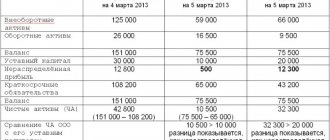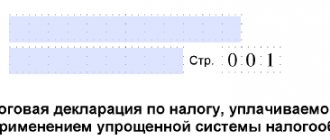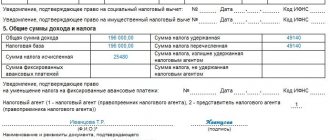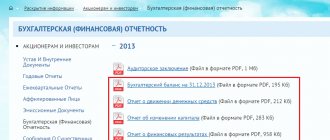Restoration of VAT upon division or allocation
The taxpayer previously paid VAT, but is now switching to the simplified tax system. He needs to restore VAT on unused goods and materials, on the residual value of fixed assets and intangible assets (subclause 2, clause 3, article 170 of the Tax Code of the Russian Federation). Reorganization will help avoid VAT reinstatement.
For example
In January, the enterprise worked under the general system and can officially switch to the simplified tax system only next year.
But the company carried out a reorganization - division into several legal entities. They were created on January 24 and are considered new organizations (this is clear from paragraph 3 of Article 58 of the Civil Code of the Russian Federation). This means that they can apply the simplified tax system from January 24, the date of state registration (clause 2 of article 346.13 of the Tax Code of the Russian Federation). You only need to submit a notification about the use of the special regime (within 30 days, counted from the date of registration with the Federal Tax Service). According to the letter of the Federal Tax Service of Russia dated March 14, 2012 No. ED-4-3 / [email protected], the “simplified” must restore VAT on the property received during the reorganization. VAT is reflected in line 080 of section 3 of the declaration for the period when the “simplified” is registered (for us - the first quarter)*. The Administration of the North Caucasus District has a different opinion: the restoration of VAT during reorganization contradicts paragraph 8 of Article 162.1 of the Tax Code of the Russian Federation. As for the transition to the special regime, the VAT previously accepted for deduction by the taxpayer is restored (subclause 2, clause 3, Article 170 of the Tax Code of the Russian Federation). But the company created after the division did not deduct VAT, since it did not operate in the general regime. This means there is no reason to restore. The court recognized the illegality of additional VAT charges and canceled penalties and fines for non-payment of VAT and failure to submit a declaration for this tax.
* If the “simplifier” restores VAT, then it can be included in costs (subclause 2, clause 3, article 170 of the Tax Code of the Russian Federation). This is relevant for a single tax under the simplified tax system on the difference between income and expenses.
If the reorganization is carried out in the form of a spin-off, in which the old company remains on the general regime, and the new one on the simplified tax system, then VAT restoration is required by the letter of the Ministry of Finance of Russia dated July 30, 2010 No. 03-07-11/323. But even here the new organization did not deduct VAT and there is no reason for restoration (see, for example, resolutions of the Federal Antimonopoly Service of the West Siberian District dated 03.14.14 No. A81-2538/2013, AS of the North Caucasus District dated 03.12.15 No. A63- 1367/2014 and FAS of the Ural District dated 02.25.14 No. F09-495/14). In addition, in the selected one (clause 8 of Article 50 of the Tax Code of the Russian Federation). This is also an argument against charging VAT.
VAT restoration when switching to the simplified tax system >>>
Accounting
The costs of registering a new legal entity are included in expenses for ordinary activities. They are recognized in the period in which they arose. It does not matter when the payments were actually transferred. Expenses will be recorded in expense accounts.
If a company changes its organizational form, it can use the services of a third-party company that will prepare documents and send them to the tax office. This action is accompanied by the following transactions:
- DT60 KT50. Payment for the services of a law firm.
- DT26 KT60. Reflection of the cost of services of a third party.
- DT19 KT60. VAT reflection.
- DT26 KT60. Duty reflection.
ATTENTION! Final reporting is prepared by the reorganized entity on the date preceding the day the entry was made in the Register.
Business purpose of reorganization affects VAT recovery
The enterprise will lose the dispute in court if the inspection proves that the reorganization is only needed to switch to the simplified tax system and reduce taxes. Therefore, the company needs to refer to the business purpose. For example, for division or separation, this could be “the transfer of non-core activities into an independent enterprise” (Resolution of the Federal Antimonopoly Service of the Volga-Vyatka District dated April 30, 2009 No. A43-9061/2008-31-183). Or assigning each organization its own region or the production of a separate group of goods (works, services). This specialization allows you to improve customer service, improve product quality, and increase income.
You can compare the annual revenue before the separation (spin-off) with the total annual revenue of all companies operating after the reorganization. If it has increased, then this is an additional argument against additional charges (resolution of the Federal Antimonopoly Service of the Central District dated March 11, 2010 No. A35-2748/09-C18, etc.). Other comparisons (profit, property value, profitability...) are also used as arguments. Other justifications for reorganization are also acceptable. Let's say, the need to write off illiquid assets from the balance sheet of one of the enterprises planning to get a loan.
The business purpose of the separation can often be determined from the organization's records. These are business plans, conclusions of consulting companies, internal memos, etc. If such documents are available, then they should be presented to inspectors and judges.
Accounting for advance payments
Let's look at an example. Reorganization was carried out according to the form of affiliation. For the period of reorganization, the company received an advance payment, on which VAT is charged. From one entity to another participating in the accession, goods were transferred without VAT. The transfer of accounts payable was also carried out. When transferring goods, fixed assets and assets to a legal successor, VAT is not restored.
Let's look at the wiring used:
- DT41. Multiplying product account balances.
- KT62/2. Multiplying account balances owed to customers.
- DT76. Multiplying VAT account balances.
- DT51. Multiplying account balances in which money is recorded.
- KT80. Multiplying balances on the authorized capital account.
- DT62 KT90. Recognition of revenue from product sales.
- DT90 KT41. Write-off of production costs.
- DT90 KT68. VAT accrual on sales proceeds.
- DT68 KT76. Acceptance of VAT deduction.
- DT62/2 KT62. Offsetting the advance amount against the buyer's debt for the products.
When preparing the final financial statements, the profit and expense accounts are closed.
VAT conversion and restoration
Another form of reorganization is transformation**. Here the new legal entity is the legal successor for the payment of tax (Clause 9, Article 50 of the Tax Code of the Russian Federation). This, according to the AS of the West Siberian District, is the reason for the restoration of VAT (resolution dated March 10, 2015 No. A03-13148/2014). In our opinion, the court's conclusion is not applicable to the controversial situation. The obligation to pay tax arises if there are grounds provided for by the Tax Code (clause 1 of Article 44 of the Tax Code of the Russian Federation). Consequently, the tax should be assessed according to the norms of the code, which does not say about the restoration of VAT upon conversion.
** The Russian Ministry of Finance is postponing the simplified tax system until the year following the transformation (letter dated May 22, 2006 No. 03-11-04/2/115). The court allows a special regime immediately after state registration (resolutions of the Federal Antimonopoly Service of the North-Western District dated April 13, 2010 No. A66-9342/2008 and the Federal Antimonopoly Service of the Ural District dated September 17, 2012 No. F09-7513/12).
The AS of the West Siberian District also stated that the taxpayer’s statements show that by avoiding “VAT restoration... it is enough... to carry out a reorganization,” although such a benefit is not provided for by the code. This means that VAT restoration is mandatory. But this is also controversial. Reinstatement is necessary in the cases provided for in paragraph 3 of Article 170 of the Tax Code of the Russian Federation. It mentions the transition to “simplified” from the general regime, and not its application by a new legal entity. This argument was taken into account by the Federal Antimonopoly Service of the Ural District (resolution No. F09-7513/12 dated September 17, 2012), recognizing the unjustified restoration of VAT during the transformation. So far, this case, like the decision in favor of the Federal Tax Service, is isolated and it is impossible to predict the outcome of the dispute. Therefore, we do not recommend reorganization in the form of a transformation. If it is nevertheless carried out and the new enterprise uses the simplified tax system, then the business purpose of the transformation must be disclosed. For example, protection against possible purchase of shares and change of owner (during transformation from JSC to LLC).
Financial statements
All taxpayers required by law to maintain accounting records must submit annual financial statements to the tax authorities.
For the transformed entity, the reporting year will be the period from the beginning of the year to the date of transformation. After registering the transformation, the legal successor must submit the final accounting statements of the legal predecessor to the tax authorities and statistical authorities within three months from the date of registration of the transformation. There are no special forms or special composition of financial statements. But there is a special code for the reporting period - 90. According to Article 16 of the Law of the Russian Federation “On Accounting” No. 402-FZ, the legal successor on the date of registration of the transformation draws up the first (introductory) financial statements. It is drawn up on the basis of the transfer act and data on the facts of economic activity from the moment of approval of the transfer act until the moment of registration of the transformation. Because Only annual financial statements are submitted to the tax authorities, then the legal successor has no obligation to provide the first financial statements to the tax authorities.
On the restoration of VAT upon accession and merger
Business purpose is important in a merger reorganization. Then, in particular, one can refer to the reduction of management costs. It is also worth relying on court cases of companies that previously worked on the common system, but joined the “simplified” system. The Federal Tax Service forced them to restore the VAT, although the legal successor, the “simplified person,” did not deduct it. Therefore, arbitration avoided the restoration of the tax (decision of the Supreme Court of the Russian Federation dated October 17, 2014 No. 307-KG14-1534, resolution of the Federal Antimonopoly Service of the North-Western District dated April 30, 2014 No. A52-1617/2013 and the Federal Antimonopoly Service of the Ural District dated January 26, 2010 No. Ф09-11294/ 09-C2).
An exception is the resolution of the Federal Antimonopoly Service of the Moscow District dated July 25, 2012 No. A40-81069/11-107-350 (approved by the decision of the Supreme Arbitration Court of the Russian Federation dated November 29, 2012 No. VAS-15228/12). Only there was a situation where, before the reorganization, the company deducted VAT on materials without planning to use the valuables. This shows the illegality of the deduction; the court demanded that VAT be calculated despite the reorganization.
Another form of reorganization is a merger. There are no separate court cases on it. But the merger leads to the creation of a new legal entity that immediately began working on the simplified tax system. He did not deduct VAT. This means that he should not restore it.
Judicial practice on restoration and reorganization
It is possible that after reorganization the company operated under the general taxation regime, and from the new year switches to the simplified taxation system. Then it restores VAT, but only on property acquired and created in its activities. The court will exempt from VAT restoration on objects received from the reorganized predecessor (see, for example, decisions of the Federal Antimonopoly Service of the West Siberian District dated September 27, 2013 No. A75-9750/2012 and the Federal Antimonopoly Service of the Ural District dated December 21, 2012 No. F09-12394/12) .
The inspectorate may also make claims against the reorganized predecessor. He transferred the property to a new legal entity - a “simplified” entity for non-taxable activities and must restore VAT. This statement of officials was not approved by the Volga-Vyatka District Autonomous District (resolution dated February 27, 2015 No. A17-3124/2014). Such restoration is directly prohibited by paragraph 8 of Article 162.1 of the Tax Code of the Russian Federation.
Article 171.1 of the Tax Code of the Russian Federation requires the restoration of VAT if the taxpayer begins to use the property in non-taxable activities. But the reorganized predecessor does not itself exploit the assets in such operations. This means there is no need to restore VAT.
Reorganization in the form of a division and the application of the “simplified procedure” by the new company is a situation that has so far been studied by only one district court. This is the AS of the North Caucasus District, which canceled the restoration of VAT (resolutions dated 03.19.15 No. A63-6184/2014 and dated 03.25.15 No. A63-6767/2014).
Scheme of actions for unitary enterprises and business societies
Due to the complexity of the procedure, several stages can be distinguished:
- Pre-registration actions.
- State registration.
- Post-registration actions.
- Registration of shares of a joint-stock company, if this type of enterprise appears as a result.
Each stage involves certain actions that have a number of features. As mentioned above, this operation is regulated by a fairly large number of regulations. You can take the time to study on your own and try to perform the conversion yourself, but theory will not save you from the mistakes that are always present when there is a lack of experience. Even if you have a lawyer on your staff, it is not a fact that he will do everything at the proper level, since a highly specialized specialist is preferable here. Let's look at the necessary steps during registration so that you can be convinced that the optimal solution is to contact MK-Legal Technologies.






